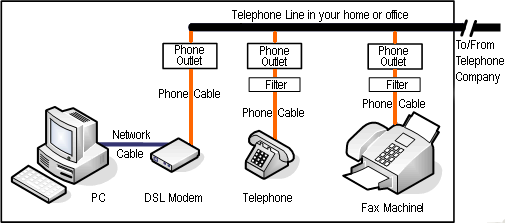Home »
Full Forms »
Technology Full Forms
What is the full form of DSL?
Full form of DSL: Here, we are going to learn about the DSL, full form of CRT, overview, types of DSL, features.
By Anushree Goswami Last updated : March 30, 2024
DSL Digital Subscriber Line
DSL is an abbreviation of Digital Subscriber Line. DSL is a channel of communication used over the line of standard telecommunication of copper wire to conduct high-speed internet. Over different types of internet access like broadband, DSL provides the perfect price, internet connectivity, and services.
Over a DSL, the transaction of data and conversation on the telephone can be done at the same time. Voice signal is transferring signals using low frequencies range (0Hz to 4 kHz), over the 'voice band' frequency range, while digital signals are transferring signals through high frequencies (25 kHz to 1.5MHz). DSL filters or splitters are used, to make clear and confirm that no phone call get intervened by high frequencies.

Image source: http://pokesoku.co/fax-line-wiring-diagram.html
DSL Types of DSL
1. SDSL
SDSL is called Symmetric DSL which makes available for use uniform bandwidth for uploading and downloading both and is almost tend to choose by all small corporations.
2. ADSL
ADSL is called Asymmetric DSL. In ADSL, downstream speed is higher than upstream. ADSL is used by those users who download more data than uploading. Uploading potential may not that much better as downloading potential. Those users who do not upload too much as compared to downloading can use ADSL. It may provide while uploading 1.5 Mbps, on the other hand, it provides as high as 20 Mbps speed in case of downloading.
3. HDSL
HDSL is called a high bit-rate Digital Subscriber Line. It is a broadband digital communication that is used between the telephone company and its clients and also inside a corporate area. It is a regular consistent line, provides uniform bandwidth in both directions.
4. RADSL
RADSL is called rate-adaptive DSL. The modem can alter bandwidth and controlling the functioning of speed to increase the transfer of data in this RADSL technology. The applications it supports are both symmetrical and asymmetrical with non-uniform speeds.
5. VDSL
VDSL is called a very high data rate DSL. It provides a more genuine experience of the internet than fundamental broadband because it is a developing DSL technology. Over short distances, it provides a huge rate of data transfer than other related services e.g. 50 to 55 Mbps over lines up to 300 meters in length.
DSL Features
- It is worldwide accessible.
- It provides more security and cost less.
- It provides a more genuine internet experience than other broadband services.
- It provides less speed in comparison to broadband services.
- It provides a restricted range due to the larger distance between the main hub DSL provider and receiver which also affects the standard of the internet.
Advertisement
Advertisement